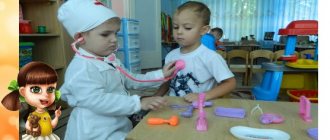Why do preschoolers need games?
In the first 5-6 years, a child studies everything that surrounds him, gets acquainted with new phenomena, and forms his own opinion. It is at this time that habits and skills are formed, which in the future will be the basis of character. Thanks to games, children learn a lot of new things, draw their own conclusions, learn to communicate, and expand their horizons and worldview. Role-playing games that help to master communication skills are important. The child learns to communicate with other children, express his point of view, and transform into a person of a certain profession or social status.
What are the benefits of role-playing games:
- The child's personality develops.
- Cognitive processes are activated.
- Kids try on various social roles.
- Children learn to interact with other players.
- The child must follow certain rules of the game.
- Self-discipline develops.
- Creative potential is being developed.
- Games help intellectual development.
- The speech apparatus improves.
What are role-playing games?
From 3-3.5 years old, children begin to actively participate in games where several children are involved. In this case, the participants play certain roles, for example, a girl transforms into a mother, and her friend transforms into a daughter.
Types of role-playing games:
- everyday (“Mothers and daughters”, “Holiday tea party”, “Visiting”, “How the family spends the day”, etc.);
- public places (“Supermarket”, “Beauty salon”, “Hospital”, “Cafe”, “Train”, etc.);
- literary (based on stories, fairy tales, cartoons, movies);
- directing (participants voice the toys and come up with a plot for them).
Some specifics...
For example, plots can generally be grouped this way:
Household – family, kindergarten;
Professional (industrial) – sellers, teachers, doctors, etc.;
Social – holidays, parades, going to a cafe, clinic, theater.
In kindergarten, we offer children a variety of storylines to give them the opportunity to comprehensively explore the world around them. If you don’t show children what they can play with, they will either spend hours rolling cars on the floor, or dressing and undressing dolls, and sometimes they just start fighting over toys, and that’s not very good.
When children play on their own, this is certainly not a bad thing, but you need to constantly expand the children’s gaming experience, involving them in new situations, so that the children do not have time to quarrel among themselves, which often happens if everything is left to chance.
There are “eternal” plots that our grandmothers also used. For example, a hospital, a school, a family, but they also have features that reflect reality. If earlier doctors in villages were called paramedics, today you will not find such a name. Yes, a lot has changed over the past 20-30 years... This is all always reflected in game moments.
Children often choose game plots based on some extraordinary event in the life of the country and the world or based on movie plots. So, in my childhood, the boys played at border guards and Stirlitz, my dad imagined himself as a scout, a Red Army soldier, a soldier in the wake of the war, and now our children play terrorists quite seriously...
What would you like to say about the content? It depends on the age of the children. The little ones are able to repeat the same action many times without getting bored. For example, they dress the dolls, put them to bed and dress them again, then everything repeats again. At the same time, children can generally do everything silently or separately, without communicating with their play partners.
Older children are already adding new lines - they are already washing the same dolls, feeding them breakfast and taking them to kindergarten or school. At the same time, with age, children learn to use substitute objects: a piece of plasticine completely replaces soap, or in general you can imagine everything, fantasize, and this is enough for complete fun.
The guys actively communicate, discuss the plot and their roles, that is, they penetrate deeper into the realities of life with the help of the game.
What games will children of 3-4 years old like?
Kids still cannot come up with a complex production with a logical chain of actions. They have too few life examples, and even the little ones do not know how to do one thing for a long time. Children usually demonstrate simple actions, repeating them after adults.
Usually kids reproduce moments from everyday life: bathing a doll, preparing food for toys, carrying baby dolls in doll strollers, etc. A little later, the baby chooses a specific social role, for example, becomes a driver and takes bears on an imaginary bus to kindergarten. Girls love to turn into mothers: they carry baby dolls in their arms, put them to bed, and place toy dishes on the breakfast table.
By the age of four, games become more varied and interesting. The baby himself chooses the role he likes and reproduces the characteristic actions. What games will be interesting for children 3-4 years old:
- “We’re packing the doll for a walk.” The baby must prepare the necessary doll clothes for the walk. He names each item of clothing when he puts it on the baby doll. It is important that the baby assembles the doll correctly depending on the weather. You can ask leading questions: “What color is this jacket? What's on the hat? Shall we take a raincoat?
- "Supermarket". Favorite game for 3-4 year old children. You can purchase a toy cash register with plastic products. There are entire sets on sale for playing shop with a counter, a moving belt, a cash register, money and even bank cards. But you can get by with homemade painted banknotes, a basket, and a set of plastic fruits and vegetables. Children decide who will be the seller and who will be the buyer. Next, the “buyer” selects the product he likes, puts it in a basket, and approaches the “seller”. He goes through each item, names the amount, thanks for the purchase, and helps put the products into a bag.
- "Visit to the doctor." The child transforms into a doctor: he lays out toy instruments, puts on a medical cap and waits for visitors. He can treat teddy bears, dolls, mom, sister or friend. You can also purchase a veterinarian's kit, which will contain all the necessary tools and a plush dog/cat. A little veterinarian can help your furry friend become healthy again.
- “Let’s go visit the doll.” Doll Masha invites friends to a tea party. The child takes other dolls and a toy cake and goes to Masha. Before this, Masha sets the table: lays out the tablecloth, places cups and saucers. Next comes the tea drinking process, where everyone communicates politely and then thanks for their hospitality.
Interesting : Child development: 3 entertaining techniques from psychologist P. Zygmantovich
Story-based play as a means of developing a psychologically healthy child
Natalia Grishkina
Story-based play as a means of developing a psychologically healthy child
Story play in Russian psychology and pedagogy is considered as the leading activity of children
preschool age (A. N. Leontyev, D. B. Elkonin, etc.).
With a special organization of the pedagogical process, a story game
becomes one of the main means contributing to normal mental development, the disclosure of individual and personal potentials of children, and, therefore, acts as a means of becoming a psychologically healthy child.
Story game
can act as a means of becoming a psychologically healthy child (as opposed to mentally healthy) only if it is organized in such a way that it allows children to achieve not only age-related norms for the development of the game as a specific children's activity, but also to realize their individual preferences in the development of its plot.
By older preschool age, children's story-based play becomes a complex formation in which different components of the game are used and intertwined - actions/events and their sequences, roles and role-playing interactions, game objects and their organization. The child improves his ability for substitutive action - from objective to purely verbal substitution, and acquires the ability to build plot combinations characterized by increasing internal coherence, regardless of whether the theme of the plot is realistic or fantastic (fictional).
At the same time, there are significant differences between children who have reached this stage (stage) of play. These differences cannot be qualified as a manifestation of a higher or lower stage (stage) of the game, but exist as variants of the manifestation of stage (stage) characteristics.
In other words, the plot play of older preschoolers appears not only in terms of general characteristics, but also in a differentiated form.
In the play of older preschoolers, there are differences regarding the nature of the development of the plot, the connection of the components of the plot, and the use of game material as a means of embodying the plot. This is evidenced by observations of children’s play recorded by various psychologists (A. N. Leontiev, N. A. Menchinskaya, V. S. Mukhina, J. Piaget, D. Selley, etc.).
These kinds of differences in the play of older preschoolers are associated with emphasis on one or another component of the children's plot, which entails the need and nature of the use of the material.
Peculiarities in the development of a coherent plot of a game, to the extreme degree of expression, form, as it were, two “poles”: the first is the emphasis in the plot of temporary connections, realized through the development and designation of the sequence of events occurring with the character (role); the second is the emphasis in the plot of subject-spatial connections - the space for the implementation of events, the actions of a character (role) through the creation and designation of a subject-spatial environment.
In creating an object-game environment
An important task arises - to organize the joint play of children and support it, that is, to find for small game material an actual holistic subject field, which will determine, on the one hand, the coherence of the structural components of the plot, on the other hand, to connect the individual plans of children into a single event -spatial field. In the cultural layer of game objects used in children's play, there are specific toys that define such an integral field: game models (N. A. Korotkova, I. L. Kirillov).
By game layout we mean a reduced object sample of space and objects of an imaginary world (realistic or fantastic). However, in real implementation, models usually exist in conjunction with other plot-forming materials: character figures, individual space markers, objects indicating character events (for example, Lego models).
A thematic set of game material, as can be seen in children’s play, “contains”, offers a functional scheme for the development of the plot, imposing on children a certain theme of the plot, which makes it easier for children to unfold the event plan, helps to “generate” the game plan itself, but can restrain individual freedom in the game .
Role-playing games for children 4-5 years old
At this age, it is important for children to choose the role that they like best. Dialogues with other participants, through which information and emotions are exchanged, are important in the process. Preschoolers are able to come up with a coherent plot with the development of events, and distribute roles between the participants. They enjoy fantasizing and coming up with interesting stories.
Suitable games for preschoolers:
- "Circus";
- "In Space";
- "In the restaurant";
- "Journey to Another Continent";
- "ONE HUNDRED";
- "Airplane";
- "On the ship", and much more.
Children at play
It is interesting to observe how the nature of the role that a child assigns to himself and his play partners changes from a younger age onwards. At first, the baby performs the actions that parents usually perform with him - wash him, undress him, dress him, put him to bed. He does not imagine himself, say, as a mother, but he copies her movements.
Next comes voice acting - the kids speak instead of the dolls. And only later do they name the roles they take on: I am a mother, I am a daughter, I am a dog. Preschoolers no longer only adhere to the logic of actions, but also demonstrate an understanding of the meaning of social relationships.
At this stage, emotional clashes between children during the distribution of roles are possible. It is imperative that we, adults, stop conflicts and teach children to fairly choose and assign roles. You can show them how to solve the problem of choice using a counting rhyme or lot.
What if we started a discussion on this topic? I have long wanted to have scientific debates with colleagues! Please express “smart” thoughts, valuable comments, and unique suggestions!
You can even subscribe to new materials, and don’t forget to share links to your favorite articles.
Sincerely, Tatyana Sukhikh
See you!
By the way, I recommend reading:
What moms say
Maria, mother of four-year-old Dasha: “My daughter loves to play with dolls. We come up with different stories: the mother goes for a walk with the child, feeds the baby, bathes, and changes clothes. It’s so touching to watch how Dasha feeds the baby doll porridge in the morning and sits him in a toy chair. Then he rolls along the street in a stroller, bathes him in a toy bubble bath in the evening, and wraps him in a towel. I believe that such games prepare children for later life, because one day Dashenka will raise her own child.”
Olga, mother of five-year-old Miroslav: “Friends often come to visit my son, and they play construction together: they build buildings from blocks or construction sets. They often play hospital, where one of the children becomes a doctor, and the rest voice the toys who are sick and need help.
I know that role-playing games are important for children’s development, so I come up with interesting stories myself. For example, we recently staged a theatrical performance: we wrote a script, seated teddy bears on chairs, and turned on music. Miroslav really enjoyed performing “on stage.”
Parents should remember that role-playing games are important in the development of intelligence, as well as communication and creative skills in children.
It is necessary to encourage in every possible way the child’s desire to play “Daughters-Mothers” or “Hospital”, as well as come up with new storylines in which the child can learn something new. leave a comment






